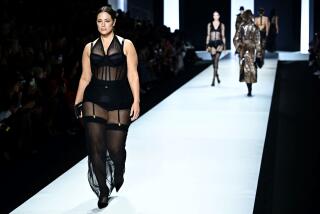If the Vanity Fits
- Share via
Judie Thomas used to be a perfect size 6, but today the 53-year-old San Clemente resident can wear size 4s and even size 2s. Thomas’ figure hasn’t gotten smaller--clothing sizes have gotten bigger.
“I no more wear a size 2 than the man in the moon,” Thomas admits. “I feel the designers are trying to make women feel good [by expanding the sizes], and I have to admit that I’m thrilled when I’m a 4, but . . . .”
As Thomas suspects, clothing companies have taken poetic license with their garments’ hangtags, slapping a size 4 or 6 label on a skirt or dress that once merited a size 8 or 10.
Such vanity sizing is designed to flatter customers--primarily women--into thinking they can still wear a tiny size even though their waist and hips would argue otherwise.
“In the early ‘40s, a size 8 was a 23 1/2-inch waist, and today it’s about 27 inches,” says Janet Gregg, fashion merchandising instructor at Fullerton College. “And hips--hang on to this--were 34 1/2 and now they’re 37 1/2.”
Consider an episode from the 1950s sitcom “I Love Lucy”: Lucy has to shed 15 pounds off her 132-pound frame to “squeeze” into a size 12 costume if she wants to--what else?--land a part in Ricky’s show. By today’s standards, even a size 12 would be too large on Lucy. Weighing in at 132, she’d probably wear a size 8.
Shoppers’ egos are a factor in size deflation. Manufacturers know consumers like to fit into a smaller size, so they mark the garment one size down.
“A lady who fits a size 14 is much more likely to buy a size 10,” says Doris Fuqua, coordinator of the fashion program at Fullerton College. “Just look at all the diet commercials. They all say, ‘Now I can fit a size 8.’ But that 8 used to be a size 12.”
The college’s Fashion Careers department, which teaches the business of fashion, is 20 years old. But the college has offered fashion courses since it opened in 1915. Students work on a mix of old and new dress forms, and they’re unpleasantly surprised to see that the size 8 they built on an old form doesn’t fit a modern size 8 wearer.
Clothing labels should come with a warning: Objects in the dressing room mirror are larger than what appears on the hangtag.
Four or five decades ago, women could fit into that unforgiving size 8 because they were smaller and girdled into their clothing.
“Today’s woman is carrying extra weight,” says Ellen Goldsberry, director of the Southwest Retail Center for Education and Research at the University of Arizona in Tucson.
Sizing has dropped lower and lower since 1940, when the now-defunct U.S. Bureau of Standards established standard sizes based on the measurements of military women to outfit them in uniforms, Goldsberry says.
Since then, there’s been no attempt to adopt uniform sizing. Manufacturers refer less and less to the original measurements and label clothing any size they want. Downsizing has reached the point where a few manufacturers have introduced size 0s.
“It’s on the books,” Fuqua says.
The lack of standard measurements has created confusion in the dressing rooms, where shoppers find that they can wear a size 8 in Liz Claiborne and a size 10 in Donna Karan.
“Hangtags are no longer a true reference point for good fit,” Goldsberry says. “A size 10 in one company is not the same as a size 10 in another.”
Shopper Thomas says she has to enter dressing rooms with two or three different sizes of the same garment to find one that fits.
“It’s the biggest pain,” she says. “I have to try everything on to see whether I’m a size 2, 4 or 6.”
Companies have different sets of measurements because they’re trying to target different markets. Liz Claiborne clothing has a generous cut, especially through the thighs, to cater to the company’s mainstream 30-plus customer, Gregg says.
St. John’s knitwear line tends to run large because of its large following of older customers, while the company’s new Griffith & Gray woven line runs a tad smaller to capture the younger market, Gregg says.
“Companies know who their customer is,” she says.
Upscale designers tend to be less forgiving. Donna Karan’s styles run close to the body, and Thierry Mugler cuts his clothes very skimpy, she says.
“I think it’s because designers don’t want heavy women wearing their clothes,” Gregg says. “Some designers even stop at size 12.”
Men’s sizes, in contrast, have remained fairly consistent over the years. A 40 short suit is still a 40 short suit, in part because manufacturers understand that many men don’t like to shop and lack the patience to lug three sizes of the same suit into a dressing room.
Yet both men and women are finding that clothes often have no numbered sizes. Manufacturers increasingly offer clothes in small, medium and large sizes or even the dubious one-size-fits-all category (“it will probably fit everybody badly,” Fuqua says).
Manufacturing clothes in fewer sizes saves companies money. That’s why fashions have gone from the fitted, body-conscious looks of the ‘50s to many of today’s shapeless (if comfortable) looks.
“When was the last time you saw a bust dart?” Fuqua says.
When designers want to accentuate the body, they usually do so with knits, as Donna Karan has done, rather than constructed garments.
To end the clothing confusion and establish uniform sizes, the American Society for Testing & Materials, which oversees quality control in the apparel industry, recently took measurements of 7,000 American women. Unlike the government’s 1940 study, which measured only military women (a generally youthful and fit population), the ASTM collected data on a broad cross-section of women of different ethnic groups and ages.
Goldsberry, an ASTM textiles committee member, says the society is encouraging manufacturers to adopt standard sizing or print measurements along with the size on their labels. The hangtags would cut shopping time because women wouldn’t have to go into dressing rooms and “try on and try on until they find things that fit,” she says.
If such measures are adopted by the fashion industry, shoppers who have relied on hangtags to lull them into a false sense of fitness might be in for a sticker shock. So far, however, manufacturers have been reluctant to broadcast their sizing criteria.
“People who say, ‘By gosh, I can still wear a 10’ don’t realize that that 10 used to be a 14,” Goldsberry says. “Manufacturers aren’t real anxious to bring that to people’s attention.”





